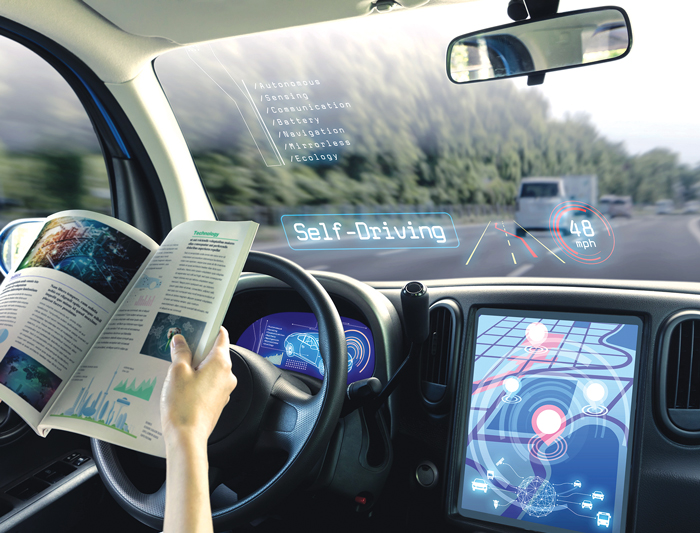By Chris Hotham Carroll
 The latest technology is essential for today’s ground transportation providers: reservations, dispatch, fleet management, training, safety, and more all depend on cutting-edge programs and devices. At the same time, some disruptive innovations, such as TNCs and autonomous vehicles, do present unique challenges.
The latest technology is essential for today’s ground transportation providers: reservations, dispatch, fleet management, training, safety, and more all depend on cutting-edge programs and devices. At the same time, some disruptive innovations, such as TNCs and autonomous vehicles, do present unique challenges.
Keeping up to date with technology can be difficult, since advancements are often happening at a dizzying pace. It is easy to feel overwhelmed and unsure of what trends to follow and where to find relevant information for your business.
There are three technology categories that have been the prime focus of many leading tech experts this year, and have been thoroughly discussed in the media, including magazines, podcasts, webinars, blogs, and YouTube videos.
5G Wireless Network
If you haven’t heard yet, the 5G wireless network is rolling out this year, and with it comes ultra-fast speeds and improved latency: Compared to the 4G network, 5G promises to be 20 to 100 times faster. These much-improved speeds will in turn allow for other technologies to fully launch. Below is a short list of examples that the 5G network will directly influence.
• Internet of Things: The IoT is exactly what it sounds like, an interconnected network of things using standardized communication. In today’s homes, we are seeing more and more items that communicate with each other, as voice assistants like Alexa and Google Assistant, smart appliances, and lighting are now seamlessly connecting our lives. Increasingly, we are hearing about “smart offices” that use IoT technology to streamline processes, gather data, and save time and money. The 5G network will allow for much faster communication between these connected devices. With them, you can be alerted if the temperature on the thermostat is raised or even turn off the coffee pot in your idle breakroom from home, saving you money.
• Public Safety: Municipalities will be able to take advantage of super speeds obtainable through the 5G network, much to residents’ benefit. In real time, communities will be able to monitor and respond to arising issues. For instance, public works departments will potentially know when a single street light is out. When there is an expansive power outage, utility companies will immediately know exactly how far-reaching the problem is. In areas with flood risk, rising waters can be easily monitored.
• Remote Control for Heavy Machinery: The 5G network will allow for heavy and specialized machinery to be remotely controlled in real time. This will then allow for humans to be removed from dangerous environments and work to be completed more efficiently. Within the mining industry, for example, this will greatly reduce accidents and cost, but similar tech could eventually be used in mechanical bays.
• Health Care: With ultra-reliable low-latency communication (URLLC), the 5G network will allow for telemedicine to truly become a reality. Remote patient monitoring will be possible with connected devices checking (in real time) all of a person’s standard metrics such as blood pressure, pulse, and temperature. In addition, remote surgery will also become available, offering mobile options in ambulances, disaster zones, and other isolated areas where a surgeon may not be readily available or the patient is not immediately accessible to them.
Autonomous Vehicles and Automotive Technology
Within the broad category of the ground transportation industry, most discussion of autonomous vehicles focuses on the effect that fully self-driving cars would have on chauffeured luxury transportation. This was definitely on the minds of vendors and attendees of the recent Customer Electronics Show (CES) in Las Vegas this past winter. Carmakers continue to invest huge sums of money in this technology, but the news over the past year indicates that earlier predictions of full adoption were a bit too optimistic. Analysts still believe autonomous vehicles will become a reality, but ethical, financial, and technological concerns mean we probably won’t see self-driving cars taking over the roadways in the immediate future.
Luxury brands, such as BMW, Audi, Cadillac, Mercedes-Benz, Jaguar, and Tesla, have all released vehicles in the past year that have semi-autonomous capabilities, though. Artificial intelligence is constantly improving with functionalities such as auto-pilot, super-cruise, and traffic jam assistance. With the URLLC 5G network available, vehicles will be able to communicate with each other and receive updates from roadside infrastructure including information regarding road conditions, congested traffic areas, weather, and accidents—all updated in real time. There will be a cooperation between vehicles to avoid hazardous situations and improve traffic patterns.
"In the coming years, expect to see these autonomous capabilities—before vehicles become fully self-driving adding value to our industry."
In the coming years, expect to see these autonomous capabilities—before vehicles become fully self-driving—adding value to our industry. Companies will have multiple vehicles on the road communicating with each other, helping chauffeurs avoid traffic problems or accidents. Autonomous technology also has the potential to increase passenger safety.
If you’re shopping for a new sedan, you’ll also see many new options and improvements in technology from previous years. Here are some items to be on the lookout for in 2019.
• Connected Mobile Apps: The newest connected smartphone apps now allow owners to check on-board diagnostics (OBD). These metrics may include fuel levels and service records, MPG calculations, tire pressure, realtime GPS speedometer and compass, as well as engine and transmission diagnostics. In addition, some apps can control door locks and allow for remote start. Because most of these apps require a subscription, be sure to ask about any related fees and number of users allowed.
• Adaptive Cruise Control: Because of artificial intelligence, advancements in cruise control are made each year. Using a wide array of sensors, driver assist systems can now match a vehicle’s rate of speed with the car in front, maintaining a safe following distance and making it much less frustrating when commuting in heavy traffic. Some systems can even control braking, allowing the car to handle stop-and-go traffic during traffic jams.
• Automatic Emergency Braking: Similar to adaptive cruise control, automatic emergency braking (AEB) uses sensors to predict if a crash is imminent. The car then engages the brakes to diminish impact or avoid collision altogether. This feature will come standard on all vehicles as of 2022 but many cars already have it today.
• Stolen Vehicle Tracking Software: Using the internal GPS system, tracking software is now being bundled into on-board assistance systems, making it relatively easy for law enforcement to pinpoint a stolen vehicle.
• Lane Departure Warning: When distracted, it is easy for a driver to drift from the driving lane. With lane departure warning systems, the vehicle will signal the driver with a visual, audible, or vibration alert, warning the driver that the vehicle has crossed a lane line.
• 360-Degree Camera: This system works by merging together several images from cameras located around the vehicle, usually in the front grille, beneath each door mirror, and one at the rear. The cameras fitted under the mirrors have wide-angle lenses that take in the entire side of the vehicle. Software then combines the images to provide a top-down view, allowing the driver to virtually see all surroundings. This technology can help in crowded parking lots, but also while pulling into a garage or parallel parking.
Wearables
Wearable technology is becoming more and more common, and this trend is set to continue in 2019. From smartwatches to smart earbuds to other wrist-worn devices, sales of wearables are forecast to grow to nearly 200 million units this year.
Odds are favorable that you regularly encounter passengers using wearable technology, such as smart watches or fitness trackers from companies like Apple, Garmin, and Fitbit, but the list of options just expanded exponentially beyond average heart rate and steps taken.
"Technology moves quickly, and it’s only improving as devices learn to communicate and create more modern conveniences for businesses and homes alike."
 WT2 Real-Time In-Ear Translator: This hands-free wearable allows for two people that speak completely different languages to freely communicate. Each person wears an ear bud and you choose the languages in the connected app. Although this is certainly useful for personal travel, its greater benefits may be realized in business and military applications. Operators located in multi-lingual areas could greatly improve communication between chauffeurs and passengers with these devices.
WT2 Real-Time In-Ear Translator: This hands-free wearable allows for two people that speak completely different languages to freely communicate. Each person wears an ear bud and you choose the languages in the connected app. Although this is certainly useful for personal travel, its greater benefits may be realized in business and military applications. Operators located in multi-lingual areas could greatly improve communication between chauffeurs and passengers with these devices.
App-Elles Bracelet: This is a free app made specifically for women and girls who are potentially in a dangerous situation. It enables users to quickly alert emergency contacts that have been set up through the app with warning, calling, or searching-for-help features. In addition, users may purchase the App-Elles bracelet that allows for one-touch assistance. The bracelet then alerts emergency contacts who can then access real time GPS tracking in addition to live audio recording.
Music: Not Impossible: This unique tech has users wearing wrist and ankle bands along with a harness to experience music in a whole new way. Audio vibrations are sent wirelessly to the user’s body, allowing what the inventors describe as a “surround body experience.” Originally developed for the deaf, this new technology is now finding a home with music festival enthusiasts as well. Creative bus companies may offer them to passengers enjoying their vehicle’s upgraded sound system for a night out on the town.
Technology moves quickly, and it’s only improving as devices learn to communicate and create more modern conveniences for businesses and homes alike. Check back for our midyear review to see all of the latest, as well as a review of some of the more important technologies that will become critical for chauffeured transportation companies moving forward. [CD0419]
Chris Hotham Carroll is Director of Operations for the LMC Group. She can be reached at chris@lmc.group.

